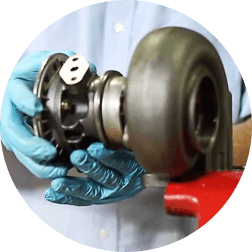
turbine failure. How to troubleshoot?
Content
the machine turbocharger, despite the durability (10 years) and wear resistance promised by the manufacturer, still fails, junk and breaks. Therefore, it is necessary from time to time to eliminate turbine breakdowns of both diesel and gasoline internal combustion engines. And in order to detect signs of breakdown in time, you should always pay attention to the non-standard behavior of the car.
The turbine is out of order:
- there is a feeling that lost thrust (reduced power);
- when accelerating a car from the exhaust pipe smoke blue, black, white;
- with the engine running whistling is heard, noise, screeching;
- abruptly increased consumption or eat oil leak;
- often pressure drops air and oil.
If such symptoms appear, then in these cases a thorough check of the turbine on a diesel engine is necessary.
Signs and breakdowns of a turbocharger
- blue exhaust smoke - a sign of oil burning in the engine cylinders, which got there from a turbocharger or internal combustion engine. Black indicates an air leak, while white exhaust gas indicates a clogged turbocharger oil drain.
- The reason whistle is an air leak at the junction of the compressor outlet and the motor, and the rattle indicates the rubbing elements of the entire turbocharging system.
- It is also worth checking all the elements of the turbine on the internal combustion engine, if it turns off or at all stopped working.
At the heart of all turbocharger malfunctions - three reasons
Shortage and low oil pressure
appears due to leakage or pinching of oil hoses, as well as due to their incorrect installation to the turbine. It leads to increased wear of the rings, the shaft neck, insufficient lubrication and overheating of the turbine radial bearings. They will have to be changed.
Oil contamination
It happens due to the untimely replacement of the old oil or filter, the ingress of water or fuel into the lubricant, the use of low-quality oil. Leads to bearing wear, clogging of oil channels, damage to the axle. Defective parts should be replaced with new ones. Thick oil also harms the bearings, as it deposits and reduces the tightness of the turbine.
Foreign object entering the turbocharger
Leads to damage to the blades of the compressor wheel (hence, the air pressure drops); turbine wheel blades; rotor. On the compressor side, you need to replace the filter and check the intake tract for leaks. On the turbine side, it is worth replacing the shaft and checking the intake manifold.
The device of the turbine of the internal combustion engine of a car: 1. compressor wheel; 2. bearing; 3. actuator; 4. oil supply fitting; 5. rotor; 6. cartridge; 7. hot snail; 8. cold snail.
Is it possible to repair the turbine yourself?
The turbocharger device seems simple and straightforward. And all that is needed to repair a turbine is to know the turbine model, engine number, as well as the manufacturer and have spare parts or a factory repair kit for turbines on hand.
You can independently carry out visual diagnostics of the turbocharger, dismantle it, disassemble and replace the defective elements of the turbine, and install it in place. Inspect the air, fuel, cooling and oil systems with which the turbine closely interacts, check their operation.
Turbine breakdown prevention
In order to extend the life of the turbocharger, follow these simple rules:
- Change the air filters promptly.
- Fill with original oil and high-quality fuel.
- Completely change oil in the turbocharging system after every 7 thousand km mileage.
- Observe the magnitude of the boost pressure.
- Be sure to warm up the car with a diesel engine and a turbocharger.
- After a long drive, let the hot engine cool down by idling for at least 3 minutes before turning it off. There will be no carbon deposits that harm bearings.
- Regularly carry out diagnostics and take care of professional maintenance.